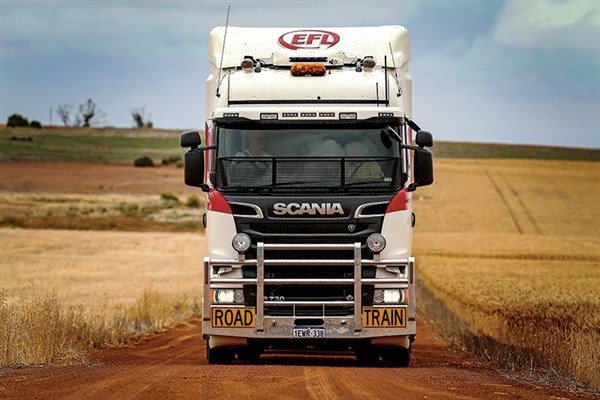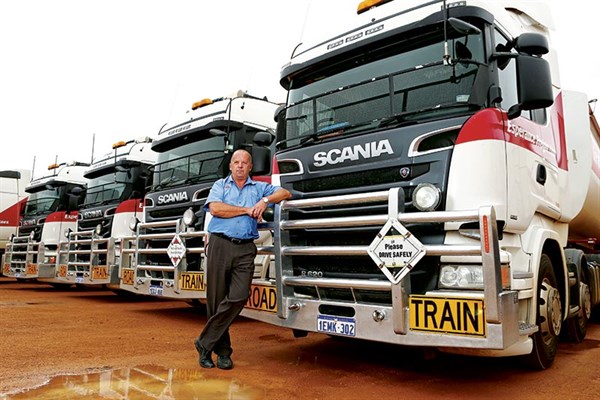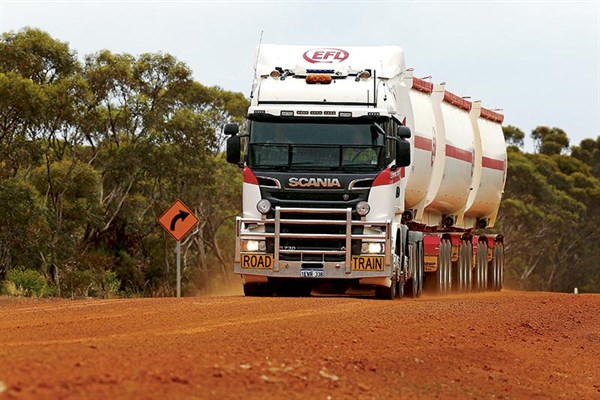The Scania R730 is the most powerful road-going truck on the Australian market. MATT WOOD heads to WA to finally get some pudding on the back of the big V8.
It’s a typically Australian rural idyll: rolling hills wear the golden mantle of harvest and stretch to the horizon, while hordes of blowflies flit through the air looking to settle on anything with a pulse.
In the distance a prime mover towing multiple trailers rumbles down a red dirt track, the sound of its big diesel engine steadily growing in volume.
You may expect that truck to be sporting a towering radiator grille and a massive bonnet – all bullbar, exhaust stacks, air cleaners and attitude.
However, it’s a European cab-over that steadily rumbles closer; a twin-steer Scania R730 hauling a West Australian C-train combination.
Overview
Sixteen litres, 730hp, 3500Nm, 16 axles, 60 tyres, 80 tonnes of grain and a grinning bald-headed nuffy (that’d be me) behind the wheel.
It won’t be long before Scania is the last man standing to offer a big bent-eight on the truck market.
And while emissions technology may have dulled its aural drama over the past decade or so, the Scania donk has a character all of its own when it’s working hard.
The trouble is, I don’t think I’ve ever really heard that hefty eight-iron work hard at all. The 730 barely raises a sweat as a B-double, and even an 80-tonne-gross B-triple is a walk in the park for the Scania flagship.
So for a while now I’ve wanted to take the big banger for a drive in an application that actually makes all 730 ponies and 3500 Newton metres take a deep breath and pull.
The test
That application turns out to be with Esperance Freight Lines in WA’s south.
The Esperance-based company has grown from a five-truck, 20-trailer operation to a 73-prime-mover, 300-trailer fleet company. In the words of owner and manager Michael Harding, EFL transports anything and everything “bar stuff that sh*ts”.
Half of that fleet is now made up of Scanias – six of them R730s – and according to Harding, “comfort and reliability have been a key part of the purchasing decision”.
I arrive while harvest is in full swing. Local tippers and out-of-town subbies are working hard to keep up with what is predicted to be a bumper harvest for the Esperance zone, with 3.3 million tonnes of grain expected to be stripped.
EFL has 26 trucks dedicated to harvest work as well as using subbies over the season. Outside of harvest time these trucks spend their time hauling bulk product like fertiliser.
For bulk tipper work, EFL uses the 35.5m-long C-train combination. This is essentially made up of an 8×4 prime mover, a B-double combination and a dolly and dog trailer.
With concessional loading the whole rig can gross up to 121.5 tonnes, which in the case of the Scania means a payload of up to 82 tonnes.
I’m keen to see how the jigger will handle a decent load on its back, so we head out to the Wittenoom hills some 70 kilometres from Esperance.
Setup
The latest addition to the EFL fleet sits waiting under a field bin auger. Harvest waits for nothing and no one, and although only two weeks old this Scania R730 has already notched up 4400km.
Behind the Scania is a three-trailer C-train tipper combination – the West Australian interpretation of an AB triple, with the B-double set at the front and a tri-axle dolly and dog trailer at the back.
With concessional loading for harvest, this whole combination is good for an 80-tonne legal payload. This makes a gross weight of 121 tonnes, which no doubt would be a good test of the 730’s 16-litre V8.
By the time grain has finished trickling out of the auger we are tipping the scales at 115.5 tonnes, which means a payload of 78 tonnes.
This 730 is sporting an air-suspended twin-steer set-up, so I am very curious to see how it handles the variety of road surfaces, especially with a dolly hanging off the back.
The C-train combination is relatively compact at 36.5m long and tracks very nicely.
The 12-speed Opticruise AMT holds the gearchanges back as we roll along the dirt tracks, until we get some momentum up.
Performance
I fire up the big V8 and point the triple toward the gate and beyond to the road into town.
Out on the country dirt road I give it some more gas and let the donk knuckle down and work.
At this point I think it might be interesting to play with the transmission’s three different performance modes: Standard, Eco and Power.
The Eco mode actually works quite well even at this weight, jumping up a cog at around 1500rpm and dropping back to 1050rpm.
Even then the big bent-eight has enough grunt to haul the tacho needle back up for the next gearchange.
Power mode holds the gears for longer, giving about 1900rpm before the next change.
However, the middle-of-the-road standard setting does the job just fine, using rpm where needed but letting the momentum of the combination give it a helping hand.
This truck is running hub-reduction axles and a final drive ratio of 3.67:1. This is taller than the previous 730s in the fleet, which have traditionally run with a 3.96:1 rear end.
While this new truck may be running a taller diff ratio, Rob isn’t complaining about the pulling power of the Scania at all.
And I must say that going by my stint in the captain’s chair there certainly doesn’t seem to be any laziness in the 730 under load.
The stability and handling of the air-suspended twin-steer axles is superb, even on dirt and rough, broken blacktop.
Where some twin-steer set-ups can feel like you are hitting every bump twice, the Scania lets larger bumps roll though the front end without a double impact.
Given the short drawbar between the dog trailer and the rest of the combination, I am expecting the rear trailer to be a little jittery at highway speeds.
But given the stability and ride provided by the front end, the dog trailer tracks along nicely, with very little sway on the rough stuff.
Power
Getting up to speed brings out a hairy-chested, if muted, exhaust note I’ve never heard from the big banger before.
It really is hauling. However, its 3500Nm can most be felt once it is cruising on the highway at 95-100km/h.
The Scania only gives you peak torque in the top two gears of the Opticruise ’box, which means the donk does a sensational job on highway hills, reducing tranny down-changes.
It simply rolls along, lugging down where needed but maintaining a good average speed.
If the V8 is the star of the show, the Scania retarder isn’t too far behind.
A bit of forethought on approaching an intersection means I can pull up the rig, lift my foot off the brake pedal and keep the 730 rolling even at such a large weight. It really is impressive.
Verdict
As sheets of torrential rain blow in from the southern ocean we roll into the CBH terminal and onto the weighbridge.
Most of the grain will be trucked back here before being shipped from the port. Rob winds the tarps back to let the robot grain samplers do their thing.
We then head to the grain-cleaning facility around the corner to tip off.
And it is here I bid the Scania farewell. It has been a revealing drive indeed, and has impressed me more than any previous drive in the 730.
I’ve been guilty in the past of saying the R730 is more an exercise in vanity than a serious heavy-hauling contender.
But this drive in the big Swede really did open my eyes to the capabilities of the smooth-performing Scania powerhouse.
Specifications
Scania R730 8×4
Engine: 16 litre Euro 5 V8 with Selective Catalytic Reduction
Power: 730hp
Torque: 3500Nm
Transmission: 12-speed Opticruise automated (AMT)
Front axles: Air-suspended load-share, twin-steer
Rear axles: Hub-reduction bogie drive
Don’t miss the full review also in the upcoming issue of Farms and Farm Machinery magazine.
Click on the link below to subscribe to the magazine and never miss an issue:






